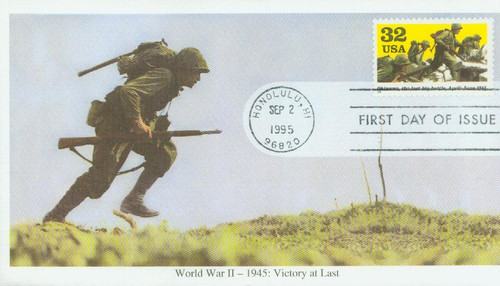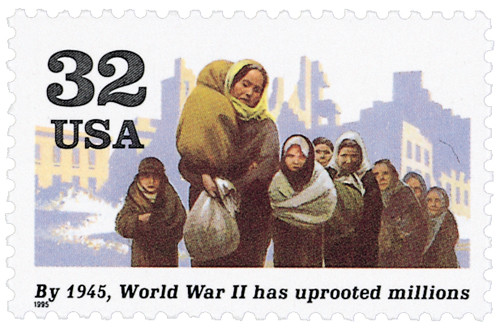
# 2981i FDC - 1995 32c World War II: News of Victory Hits Home
U.S. #2981i
Japan’s surrender hits home, August 14, 1945 – World War II
- Fifth and final souvenir sheet issued to commemorate the 50th anniversary of World War II
- Includes 10 stamps plus a world map
Stamp Category: Commemorative
Series: World War II
Value: 32¢ (Denomination of each individual stamp)
First Day of Issue: September 2, 1995
First Day City: Honolulu, Hawaii
Quantity Issued (if known): 100,000,000
Printed by: Bureau of Engraving and Printing
Printing Method: Offset, Intaglio
Format: Sheetlets of 10 (arranged in 2 strips of 5, one across the top and one across the bottom of the sheetlet, with world map in between)
Perforations: 11.1 (Eureka off-line perforator)
Tagging: Overall, large block covering stamps and part of selvage
Why the stamp was issued: This souvenir sheet was issued to commemorate the 50th anniversary of World War II. It was the last in a series of five that were issued over the course of five years.
About the stamp design: This design was based on the famous photo taken by Alfred Eisenstaedt and published in Life. The photo depicts a soldier celebrating the news of the surrender by kissing a nurse. In reality she was a dental hygienist getting out of work and didn’t know this soldier at all. William Bond had a similar dilemma as with the Iwo Jima stamp – taking a very vertical image and making it fit on a horizontal stamp without losing its significance. At first, he cropped this image in very tight, but it was thought it the kiss looked too rough and would do better if zoomed out a bit and the grip loosened. In the end Bond zoomed the image out a touch and loosened the grip of the soldier and added some people to the background. Everyone agreed that this moment caught the feelings of V-J Day perfectly!
First Day City: The stamps were dedicated in Honolulu, Hawaii. Aboard the aircraft carrier USS Carl Vinson, the ceremony took place in view of the USS Arizona Memorial.
About the World War II Series: As the 50th anniversary of World War II was approaching, the US Postal Service wanted a series that would recognize the key events of the war and the important contributions America made to the Allied victory. Rather than issue a large number of stamps, the USPS decided to create five sheetlets, each commemorating one year of America’s involvement in the war. Each sheetlet had 10 different stamps arranged in two horizontal strips of 5. In the center was a world map with Allied and neutral nations in yellow and Axis-controlled areas in red. Notes on the map highlighted key developments that occurred that year. The stamps each featured important events that took place during the year, as well.
History the stamp represents: The people of Japan heard the voice of their emperor for the first time ever when he announced, in a radio broadcast, that the war was over. The Japanese were devastated – most responded by openly weeping. America’s response to the news was one of pure joy.
V-E Day celebrations had been stifled by the sobering realization that the war in the Pacific was still to be fought. But with the Japanese surrender, the war was truly over. Whistles blew, church bells rang, crowds filled the streets, employees left work early, and strangers embraced as the nation erupted in celebration.
Japan surrendered on August 14th, but the official ceremony was held September 2nd aboard the US battleship Missouri anchored in Tokyo Bay. Two Japanese officials, as well as representatives from US, Great Britian, China, Russia, the Netherlands, New Zealand, Canada, France, and Australia signed the surrender document. September 2nd has been celebrated as V-J Day or Victory over Japan Day ever since.
Excitement subsided as serious speculation about the future began. People everywhere wanted to be sure the world would never suffer through such a calamity again. This hope was expressed October 24, 1945, when the United Nations was signed into existence.
U.S. #2981i
Japan’s surrender hits home, August 14, 1945 – World War II
- Fifth and final souvenir sheet issued to commemorate the 50th anniversary of World War II
- Includes 10 stamps plus a world map
Stamp Category: Commemorative
Series: World War II
Value: 32¢ (Denomination of each individual stamp)
First Day of Issue: September 2, 1995
First Day City: Honolulu, Hawaii
Quantity Issued (if known): 100,000,000
Printed by: Bureau of Engraving and Printing
Printing Method: Offset, Intaglio
Format: Sheetlets of 10 (arranged in 2 strips of 5, one across the top and one across the bottom of the sheetlet, with world map in between)
Perforations: 11.1 (Eureka off-line perforator)
Tagging: Overall, large block covering stamps and part of selvage
Why the stamp was issued: This souvenir sheet was issued to commemorate the 50th anniversary of World War II. It was the last in a series of five that were issued over the course of five years.
About the stamp design: This design was based on the famous photo taken by Alfred Eisenstaedt and published in Life. The photo depicts a soldier celebrating the news of the surrender by kissing a nurse. In reality she was a dental hygienist getting out of work and didn’t know this soldier at all. William Bond had a similar dilemma as with the Iwo Jima stamp – taking a very vertical image and making it fit on a horizontal stamp without losing its significance. At first, he cropped this image in very tight, but it was thought it the kiss looked too rough and would do better if zoomed out a bit and the grip loosened. In the end Bond zoomed the image out a touch and loosened the grip of the soldier and added some people to the background. Everyone agreed that this moment caught the feelings of V-J Day perfectly!
First Day City: The stamps were dedicated in Honolulu, Hawaii. Aboard the aircraft carrier USS Carl Vinson, the ceremony took place in view of the USS Arizona Memorial.
About the World War II Series: As the 50th anniversary of World War II was approaching, the US Postal Service wanted a series that would recognize the key events of the war and the important contributions America made to the Allied victory. Rather than issue a large number of stamps, the USPS decided to create five sheetlets, each commemorating one year of America’s involvement in the war. Each sheetlet had 10 different stamps arranged in two horizontal strips of 5. In the center was a world map with Allied and neutral nations in yellow and Axis-controlled areas in red. Notes on the map highlighted key developments that occurred that year. The stamps each featured important events that took place during the year, as well.
History the stamp represents: The people of Japan heard the voice of their emperor for the first time ever when he announced, in a radio broadcast, that the war was over. The Japanese were devastated – most responded by openly weeping. America’s response to the news was one of pure joy.
V-E Day celebrations had been stifled by the sobering realization that the war in the Pacific was still to be fought. But with the Japanese surrender, the war was truly over. Whistles blew, church bells rang, crowds filled the streets, employees left work early, and strangers embraced as the nation erupted in celebration.
Japan surrendered on August 14th, but the official ceremony was held September 2nd aboard the US battleship Missouri anchored in Tokyo Bay. Two Japanese officials, as well as representatives from US, Great Britian, China, Russia, the Netherlands, New Zealand, Canada, France, and Australia signed the surrender document. September 2nd has been celebrated as V-J Day or Victory over Japan Day ever since.
Excitement subsided as serious speculation about the future began. People everywhere wanted to be sure the world would never suffer through such a calamity again. This hope was expressed October 24, 1945, when the United Nations was signed into existence.












